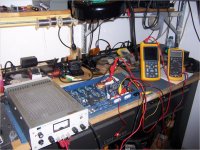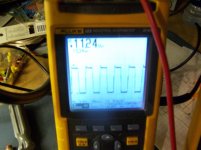Did not know you could do that. I do get +/- 40 on the rails.
Will reducing the voltage show if the PWM is good or bad. I've got a bunch of them.
Thanks Perry for all the knowledge 😎
Will reducing the voltage show if the PWM is good or bad. I've got a bunch of them.
Thanks Perry for all the knowledge 😎
A regulated power supply is designed to maintain a target voltage and will do so as long as the input voltage range is within the design parameters (11.5-14.5 is common). To prevent the voltage from varying from the target voltage, the pulse width is varied. When you vary the 12v DC supply voltage, the pulse width will vary (changing the appearance of both the gate and drain waveforms) to maintain the target voltage (whatever that is for the amp being tested).
90scaraudio, The waveform in the photo third from the left on top looks like the drain waveform. it shows a spike on the leading edge a notch then another spike on the leading edge. the leading edge is the on the left of the positive going edge. I f you are going to usde 100volt mosfets I wouldn't worry aboput it though. even 60 volt mosfets should be ok.
wadest
wadest
90scaraudio, it looks like perry answered your questions well. the 700s was not a regulated supply. if theres anything else you want to know let me know.
wadest
wadest
The 700S diagram shows feedback going back to the error amp of the SG3524. What was that feedback used for?
Why would the duty cycle be so low on the waveforms he posted if the supply wasn't regulated?
Why would the duty cycle be so low on the waveforms he posted if the supply wasn't regulated?
perry babin, there are actually three points of feedback on those amplifiers. one is what we called thermal rollback. instead of shutting the amp down when it overheated we just narrowed the pulse width until it cooled off. since it was unregulated, dynamic power was not effected only continuos average power. the second feedback point monitored current through the amps emitter resistors and above a certain amount of current the supply would switch from "high power mode" for driving 4 and 2 ohms, to "high current mode" for driving loads of 1 to 1/2 ohm and on most amps even 1/4 ohm. Essentially were lowering the rail volage which would deliver more current considering the VA rating of the supply. in reality the amps were designed to esentially capable of sucking all available power from the supply. theoretically it actually could drive a dead short or a dead short when you include the speaker wire.
at low current the pulsewidth will only run as hard as it needs to to keep the supply rails up. three, looking at it now i guess it is a soft form of regulation. it only regulated when the rail voltage was high at low power. because the rails would tend to sag at high power. the rail is fed back through a resistive devider back to pin 1. but at full output the pulsewidth would run more as a normal square wave.
I think that the answer. does that all make sense?
wadest
at low current the pulsewidth will only run as hard as it needs to to keep the supply rails up. three, looking at it now i guess it is a soft form of regulation. it only regulated when the rail voltage was high at low power. because the rails would tend to sag at high power. the rail is fed back through a resistive devider back to pin 1. but at full output the pulsewidth would run more as a normal square wave.
I think that the answer. does that all make sense?
wadest
When the power supply switches to the various modes, will the rail voltage vary in proportion to the DC input voltage from the 12v DC power supply or will it remain constant?
perry babin, yes if you raise the input voltage the rails will increase. many amps were rated at 12 volts but put out up to 1.3 x as much power at 14.4 volts. that was one of our big sales advantages. I repaired a Reference 1000s the other day and it put out 1300 watts at 1 ohm and 1/2 ohm bridged at an input voltage of 14.4 volts.
Last edited:
There are amps that are tightly regulated and can maintain the rail voltage no matter the load or input voltage (within reason). These are the types of amps that double the power output when the load is cut by 1/2.
There are others that are loosely regulated and will maintain the rail voltage up to a certain power then the rails follow the input voltage. These amps will increase in power with an increase in DC input voltage after the duty cycle has gone to the maximum possible. They are essentially acting as unregulated at high power, although they're regulated at low power and at idle.
Will the rail voltage vary in the 700S at idle if you vary the input voltage?
There are others that are loosely regulated and will maintain the rail voltage up to a certain power then the rails follow the input voltage. These amps will increase in power with an increase in DC input voltage after the duty cycle has gone to the maximum possible. They are essentially acting as unregulated at high power, although they're regulated at low power and at idle.
Will the rail voltage vary in the 700S at idle if you vary the input voltage?
perry babin, yes it will go up with higher input voltage. but you know you mentioned being able to double power by halfing the impedance. it really depends on what you want. in our Class A 5.0 and Class A 10.0 from 4 ohms to 2 ohms the power goes up by a factor of 4. the 10.0 put out 25 watts x 2 @ 4 ohms, 100 watts x 2 @ 2 ohms. as far as i know it's the only amplifier ever that increased 4 times the power by halfing the impedance. from 100 watts x 2 @ 2 ohms it goes up to 250 watts x 2 @ 1 ohm per channel and as per your suggestion it only went up from 250 watts x 2 @ 1 ohm to 500 watts x 2 @ 1/2 ohm. there, now we finally doubled the power by halfing the impedance. pretty creative huh?
perry babin, i hope you didn't take my last message the wrong way. the 10.0 was designed to be the ultimate cheater amp. in IASCA competition with one of these amps you would be considered in the 50 watt class but connected to 1 ohm bridged the amp put out 1000 watts.
Thanks,
wadest
Thanks,
wadest
Last edited:
It appears that you used a CT to send a pulse to a latching comparator to make the amp think that the rail voltage dropped so that it boosted the rail voltage with low impedance loads.
Did you try reducing the DC voltage from your power supply to see if the pulse width changed?
Just checked it out.....Yes as I lower the power-supply voltage down to 11, the pulse gets better.
Attachments
Last edited:
With the NDP7060's in it, I tested it powering a Pioneer TS-W2501D4 10in. It sounds fantastic but this sub can handle more than this 700s can dish out. I'll see how hot it gets on my drive to work in the AM. 😎
Thanks Perry and Wade for the knowledge.
Thanks Perry and Wade for the knowledge.
It gets up to about 147 Deg. almost full out.With the NDP7060's in it, I tested it powering a Pioneer TS-W2501D4 10in. It sounds fantastic but this sub can handle more than this 700s can dish out. I'll see how hot it gets on my drive to work in the AM. 😎
Thanks Perry and Wade for the knowledge.
- Status
- Not open for further replies.
- Home
- General Interest
- Car Audio
- MOSFETs, which ones to use?

